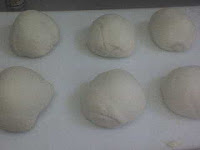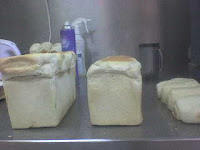Activity
Calculate each of these white doughs
Dough 1: 3% yeast
Dough 2: 0% yeast
Dough 3: 6% yeast
Dough Recipes
Dough 1
Bakers Flour………100%
Salt………………….2%
Improver……………1%
Canola Oil…………..1%
Yeast……………….3%
Water………………..60%
EYF…………………1.67
Dough 2
Bakers Flour………100%
Salt………………….2%
Improver……………1%
Canola Oil…………..1%
Yeast……………….0%
Water………………..60%
EYF…………………1.64
Dough 3
Bakers Flour………100%
Salt………………….2%
Improver……………1%
Canola Oil…………..1%
Yeast……………….6%
Water………………..60%
EYF…………………1.70
Each dough was produced using the same water temp, mixing time, proof time and baking time as the perfect loaf. The only alterations to the doughs were the yeast levels.
Each dough was a 4kg dough therefore the correct recipe was
Dough1
Bakers Flour……….4.00kg
Salt………………..0.08kg
Improver……………0.04kg
Canola Oil…………0.4kg
Yeast………………..0.08kg
Water……………….2.4kg
Doughs 2 and 3 were the same but for the yeast levels, i.e.
Dough 2-yeast……….0.00kg
Dough 3-yeast………0.24kg
Results
Each dough was removed from the bowl at 28 degrees Celsius. Each dough then was given 20mins intermediate proof time before being moulded in 4 piece blocks. Afterwards were placed into the prover. Dough 1 was proved for 1hour 5mins before being placed into the oven. Dough 2 and 3 were given approx. 1 hour prover time. Each dough was baked for 220 degrees for 28 mins.
Dough1 Correct Recipe
The first pictures below are of the perfect loaf, from the time it was moulded from the bowl, followed by its intermediate 20min proof, and before the dough was placed into the oven. The following pictures from then are of the final baked product externally and internally.
External Results
Loaf Volume(Size)- Good quality of volume, perfect size, will be easily packaged and sliced. Normal volume aspects.
Crust Colour- Lightly baked brown colour, perfectly desired colour, and nice glossy type shine.
Oven Spring- As can be seen from the pictures the loaf was placed into the oven just below the tins top, and sprung roughly a quarter in size as it baked.
Crust Character- Perfect crust character, with shiny coat, nice soft texture with regular shape and even grain.
Internal Results
Crumb Colour- Neither pale nor dark, perfectly white.
Crumb Softness- Perfect moist centre, not to dense or tough. Perfectly baked causing no doughyness, or poor strength.
Crumb Evenness- Even thickness, perfected even grain. Regular shaped, and regular sized cells.
Aroma- perfect fresh smell, not yeasty, bland, sour nor salty.
Dough 2 Insufficient Yeast
As with dough 1 pictures of dough with insufficient yeast are followed. Beginning with the dough again from the time it was moulded from the bowl, followed by its intermediate 20min proof, and before the dough was placed into the oven. The following pictures from then are of the final baked product externally and internally of a dough with insufficient yeast.
External Results
Loaf Volume(Size)- Poor quality of volume, still look like the 4 piece it was when it was placed into the tin, no fair amount of volume present, loaf was too small. When sliced the loaf began to separate and fall apart.
Crust Colour- Very poor in colour, no colour present expect really light brown patches, extremely pale.
Oven Spring- As can be seen from the pictures there was no oven spring at all, it was the same going into the oven as it was coming out of the oven.
Crust Character- no crust character present, loaf was irregularly shaped with flying top and fell apart when handled.
Internal Results
Crumb Colour- Dense crumb with a pale grey colour
Crumb Softness- Tough leathery, basically no softness at all present, was hard as a rock.
Crumb Evenness- There was no development, was flat and smooth, basically had no crumb, and was very dense and immature. This is because the loaf was too compact.
Aroma- Bland smell, gave off an aroma similar to the pasty used to make meat pies with.
Dough 3 Excess Yeast
Under the pictures of insufficient yeast are the pictures starting again from the time it was moulded from the bowl, followed by its intermediate 20min proof, and before the dough was placed into the oven. The following pictures from then are of the final baked product externally and internally of a dough with excess yeast.
External Results
Loaf Volume(Size)- Too large in quality and size, caused the dough to be over proofed. Loaf would be damaged by the slicer.
Crust Colour- darker brown colour than that of the perfect loaf, darker brown crust and more colour present on the surface.
Oven Spring- As can be seen from the pictures, the loaf had a massive spring.
Crust Character- The crust was thick and wrinkled, with a misshaped top. Irregularly shaped compared to that of the perfect loaf.
Internal Results
Crumb Colour- Poor crumb colour, paler that the perfect loaf.
Crumb Softness- The softness of the loaf was a lot softer than the perfect loaf, but felt to be slightly unbaked, still raw.
Crumb Evenness- Open/Coarse, misshapen evenness with a coarse open crumb.
Aroma- Yeasty stale smell was the aroma present.
Below again are pictures of the three doughs in comparison with one another.









Dough with Correct recipe-The Perfect Loaf....................................................................................................................................................................................
Dough with Insuffcient yeast........................................................................................................................................................................................
Dough With excess Yeast..................................................................................................................................................................................................
All Three Final Products





















No comments:
Post a Comment